English stage actress Dame Ellen Terry (1847-1928) was the leading lady of legendary stage actor Henry Irving and the Queen of Britain’s stage of the Victorian era. She later starred in several silent films. Her warmth, gentleness, and beauty made her one of the most popular actresses in Britain and the U.S., and she continued to act until 1925. Among the members of her famous family is her great nephew, John Gielgud.
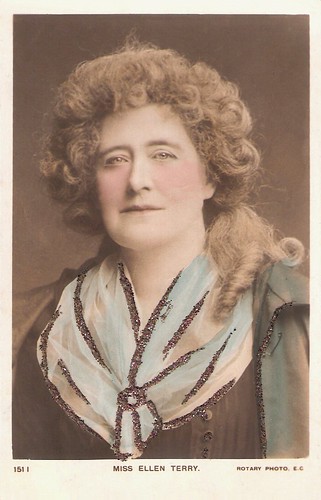
British postcard by Rotary Photo, no. 151 I.
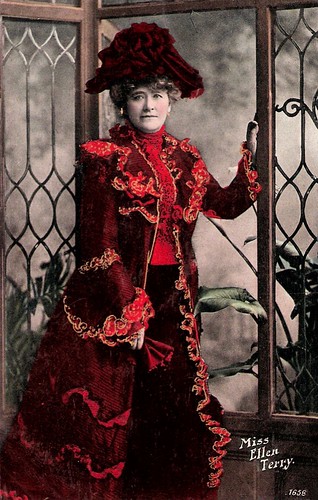
British postcard by The Rapid Photo printing Co. Ltd., London, no. 1658.
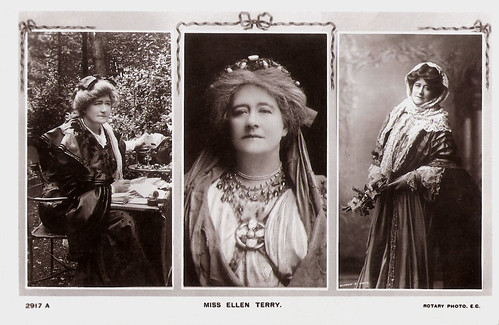
British postcard by Rotary Photo, no. 2917 A. Photo right: Window & Grove.
Alice Ellen Terry was born in Coventry, England in 1847 into a family of actors. Her parents, Benjamin Terry of Irish descent, and Sarah Terry (née Ballard), of Scottish ancestry, were comic actors in a touring company based in Portsmouth, and had eleven children. At least five of them became actors: Kate, Ellen, Marion, Florence and Fred. Two other children, George and Charles, were connected with theater management. Kate's grandson, Sir John Gielgud, became one of the 20th century's most respected actors.
Ellen Terry's first appearance on stage came at the age of eight, when she appeared as Mamillius the child under the direction of Charles Kean in William Shakespeare’s A Winter's Tale at the Princess Theater in London on 28 April 1856, with Queen Victoria in attendance. She continued to appear on stage as a teen, in London and on tour.
At sixteen she married the famous painter George Frederick Watts, thirty years her senior, and she retired from the stage. Watts's famous portraits of Terry, including Choosing and Ophelia, were more successful than their domestic affairs, however, and they separated within a year. She briefly returned to acting and in 1867, she first played opposite Henry Irving in the title roles of Katherine and Petruchio, David Garrick's one-act version of The Taming of the Shrew.
Then she began a relationship with the progressive architect-designer and essayist Edward William Godwin. With him she retreated to a house in Hertfordshire, retiring for six years from acting. They could not marry, as Terry was still married to Watts and did not finalize a divorce until 1877 – then a scandalous situation. With Godwin she had a daughter, Edith Ailsa Geraldine Craig, in 1869 and a son, Edward Gordon Craig, in 1872. She returned to acting in 1874, separating from Godwin in 1875.
In 1875, Terry gave an acclaimed performance as Portia in The Merchant of Venice at the Prince of Wales's Theatre. Oscar Wilde wrote a sonnet, upon seeing her in this role: "No woman Veronese looked upon / Was half so fair as thou whom I behold." She recreated this role many times in her career until her last appearance as Portia at London's Old Vic Theatre in 1917. Terry married again, in November 1877, to actor/journalist Charles Clavering Wardell Kelly, but they separated in 1881.

George Frederick Watts, Choosing, 1864. Source: Freeparking@Flickr.
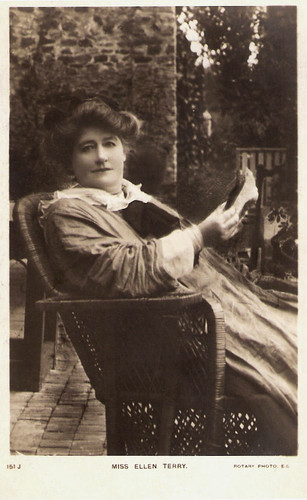
British postcard by Rotary Photo, nr. 151 J. Sent by mail in 1905.
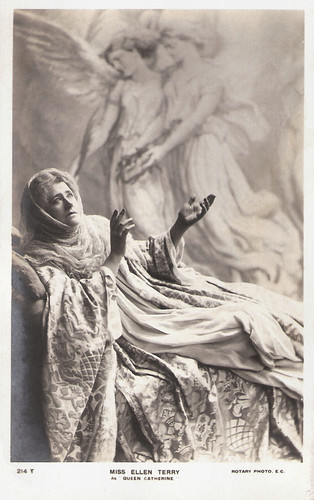
British postcard by Rotary Photo, no. 214 T. Photo: publicity still for a stage production of Henry VIII (1892-).
In 1878, the 30 years-old Ellen Terry joined Henry Irving's company at the Lyceum Theatre as its leading lady, at a generous salary, beginning with Ophelia opposite Irving's Hamlet. Her association with Irving was to become the most successful of her career, and over the next two decades she played many of the great Shakespearean heroines, including Ophelia, Lady Macbeth, Viola, Queen Katherine, Juliet, and Cordelia.
Two of her most famous roles were Portia in The Merchant of Venice, which ran for an unusual 250 nights in 1879, and perhaps most notably Beatrice in Much Ado about Nothing, a role she first performed at the Lyceum in 1882 and later revived in 1884, 1891, and 1893. She and Irving also toured with great success in America and Britain. They reigned together the British theatre in the Shakespeare canon and in Alfred Tennyson, Edward George Bulwer-Lytton, Charles Reade, Victorien Sardou, and plays by other contemporary playwrights until they left the Lyceum in 1902.
In 1903, she formed a new theatrical company, taking over management of the Imperial Theatre with her son. Here she had complete artistic control and could choose the works in which she would appear. She focused on the plays of George Bernard Shaw and Henrik Ibsen. In the 1890s, Terry had struck up a friendship, and conducted a famous correspondence, with Shaw. Theatre management turned out to be a financial failure for Terry, who had hoped the venture would showcase the set design and directing talents of her son and the costume designs of her daughter. She then toured and later also lectured.
On 12 June 1906, after 50 years on the stage, a star-studded gala performance was held at the Drury Lane Theatre for Terry's benefit and to celebrate her golden jubilee, at which Enrico Caruso sang, Eleanora Duse, Mrs. Patrick Campbell, Lillie Langtry, Herbert Beerbohm Tree, Nellie Melba, and more than twenty members of Terry's family performed in an act of Much Ado about Nothing with her, among other performances. The benefit raised £6000 for Terry.
In 1907 she toured America in Shaw’s Captain Brassbound's Conversion under the direction of Charles Frohman. During that tour, she married her co-star, American actor James Carew, who had appeared with her at the Court Theatre. She was thirty years older than Carew. Terry's acting career continued strongly, but her marriage broke up after only two years.
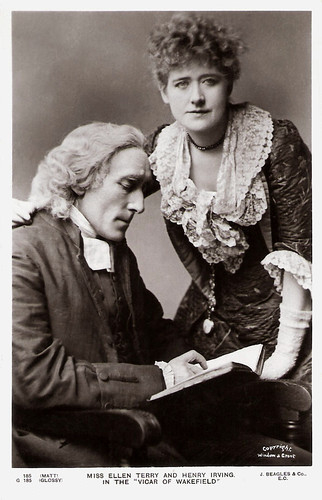
British postcard by J. Beagles & Co., London, no. 185. Sent by mail in 1905. Photo: Window & Grove. Publicity still for the stage play The Vicar of Wakefield with Henry Irving.
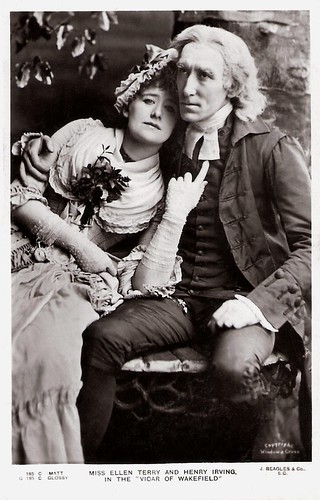
British postcard by J. Beagles & Co., London, no. 185 C. Sent by mail in 1907. Photo: Window & Grove. Publicity still for the stage play The Vicar of Wakefield with Henry Irving.
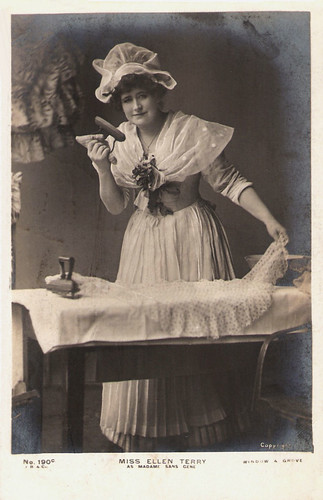
British postcard by J.B. & Co, 190C. Photo: Window & Grove. Ellen Terry as Madame Sans Gêne in the stage play Madame Sans Gêne (1897) by Victorien Sardou and Emile Moreau.
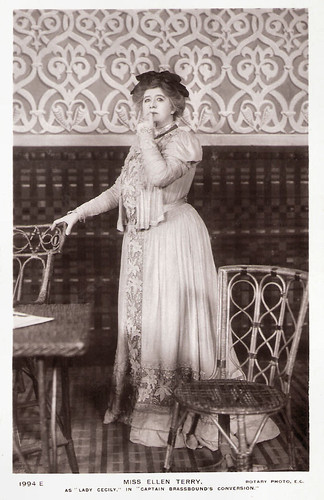
British postcard by Rotary Photo, no. 1994 E. Publicity photo for the stage play Captain Brassbound's Conversion (1906) by George Bernard Shaw.
In 1911, Ellen Terry recorded scenes from five Shakespeare roles for the Victor Talking Machine Company, the only known recordings of her voice. During World War I she performed in many war benefits. In 1916, she appeared in her first film as Julia Lovelace in Her Greatest Performance (Fred Paul, 1917) and continued to act in London and on tour.
She made a few more films through 1922, including The Invasion of Britain (Herbert Brenon, 1918), Victory and Peace (Herbert Brenon, 1918) with Matheson Lang, Pillars of Society (Rex Wilson, 1920), Potter's Clay (H. Grenville-Taylor, Douglas Payne, 1922), and The Bohemian Girl (Harley Knoles, 1922) as Buda the nursemaid, with Ivor Novello and Gladys Cooper.
She continued to lecture on Shakespeare throughout England and North America. She also gave scenes from Shakespeare plays in music halls under the management of Oswald Stoll. Her last fully staged role was as the Nurse in Romeo and Juliet at the Lyric Theatre in 1919. In 1920 she retired from the stage and in 1922 from film, although she returned to play Susan Wildersham in Walter de la Mare's fairy play Crossings, in November 1925 at the Lyric Theatre, Hammersmith.
In 1922, St. Andrews University conferred an honorary LLD upon Terry, and in 1925 she was made a Dame Grand Cross of the Order of the British Empire, only the second actress to be so honoured. In her last years, she gradually lost her eyesight and suffered from senility. Stephen Coleridge anonymously published Terry's second autobiography, The Heart of Ellen Terry in 1928.
Ellen Terry died of a cerebral haemorrhage at her home at Smallhythe Place in Kent, England, at age 81. Her career had lasted nearly seven decades. After her death, her correspondence with G. B. Shaw was published.
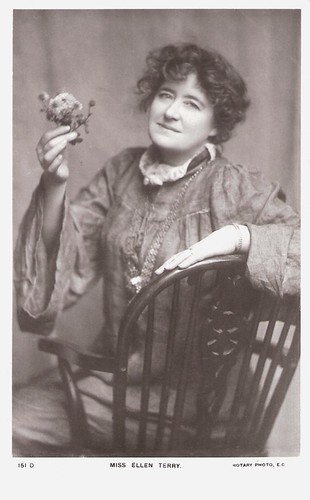
British postcard in the Rotary Photographic Series, no. 151D.
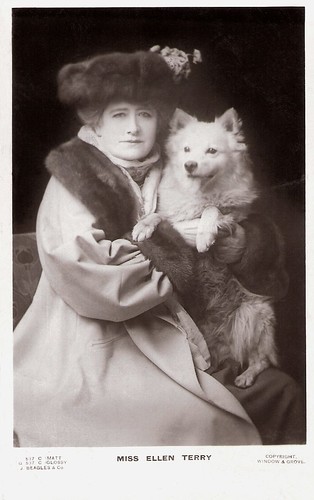
British postcard by J. Beagles & Co., London, no. 537 C. Sent by mail in 1906. Photo: Window & Grove.
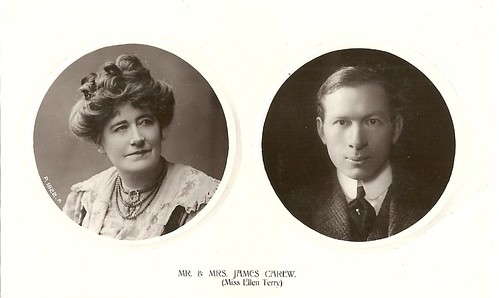
British postcard by Rotary Photo E.c., no. P.1822.a. With James Carew.

British postcard by Rotary Photo, no. 4493 G. With James Carew.
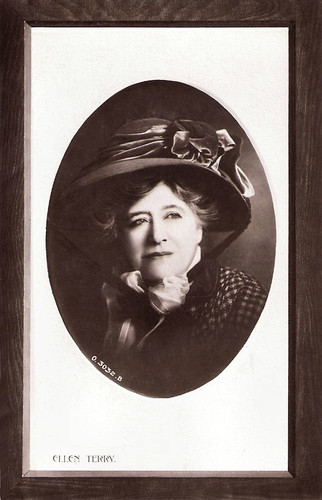
British postcard by Rotary Photo in the Opalette Series, no. 0.3032.B.
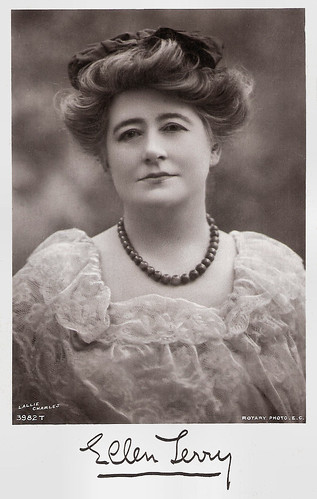
British postcard in the Rotary Photographic Series, no. 3982 T. Sent by mail in 1909. Photo: Lallie Charles.
Sources: Roger Manvell (Encyclopaedia Britannica), Gale Encyclopedia of Biography, Wikipedia and IMDb.

British postcard by Rotary Photo, no. 151 I.

British postcard by The Rapid Photo printing Co. Ltd., London, no. 1658.

British postcard by Rotary Photo, no. 2917 A. Photo right: Window & Grove.
A Family of Actors
Alice Ellen Terry was born in Coventry, England in 1847 into a family of actors. Her parents, Benjamin Terry of Irish descent, and Sarah Terry (née Ballard), of Scottish ancestry, were comic actors in a touring company based in Portsmouth, and had eleven children. At least five of them became actors: Kate, Ellen, Marion, Florence and Fred. Two other children, George and Charles, were connected with theater management. Kate's grandson, Sir John Gielgud, became one of the 20th century's most respected actors.
Ellen Terry's first appearance on stage came at the age of eight, when she appeared as Mamillius the child under the direction of Charles Kean in William Shakespeare’s A Winter's Tale at the Princess Theater in London on 28 April 1856, with Queen Victoria in attendance. She continued to appear on stage as a teen, in London and on tour.
At sixteen she married the famous painter George Frederick Watts, thirty years her senior, and she retired from the stage. Watts's famous portraits of Terry, including Choosing and Ophelia, were more successful than their domestic affairs, however, and they separated within a year. She briefly returned to acting and in 1867, she first played opposite Henry Irving in the title roles of Katherine and Petruchio, David Garrick's one-act version of The Taming of the Shrew.
Then she began a relationship with the progressive architect-designer and essayist Edward William Godwin. With him she retreated to a house in Hertfordshire, retiring for six years from acting. They could not marry, as Terry was still married to Watts and did not finalize a divorce until 1877 – then a scandalous situation. With Godwin she had a daughter, Edith Ailsa Geraldine Craig, in 1869 and a son, Edward Gordon Craig, in 1872. She returned to acting in 1874, separating from Godwin in 1875.
In 1875, Terry gave an acclaimed performance as Portia in The Merchant of Venice at the Prince of Wales's Theatre. Oscar Wilde wrote a sonnet, upon seeing her in this role: "No woman Veronese looked upon / Was half so fair as thou whom I behold." She recreated this role many times in her career until her last appearance as Portia at London's Old Vic Theatre in 1917. Terry married again, in November 1877, to actor/journalist Charles Clavering Wardell Kelly, but they separated in 1881.
George Frederick Watts, Choosing, 1864. Source: Freeparking@Flickr.

British postcard by Rotary Photo, nr. 151 J. Sent by mail in 1905.

British postcard by Rotary Photo, no. 214 T. Photo: publicity still for a stage production of Henry VIII (1892-).
A Star-studded Gala Performance
In 1878, the 30 years-old Ellen Terry joined Henry Irving's company at the Lyceum Theatre as its leading lady, at a generous salary, beginning with Ophelia opposite Irving's Hamlet. Her association with Irving was to become the most successful of her career, and over the next two decades she played many of the great Shakespearean heroines, including Ophelia, Lady Macbeth, Viola, Queen Katherine, Juliet, and Cordelia.
Two of her most famous roles were Portia in The Merchant of Venice, which ran for an unusual 250 nights in 1879, and perhaps most notably Beatrice in Much Ado about Nothing, a role she first performed at the Lyceum in 1882 and later revived in 1884, 1891, and 1893. She and Irving also toured with great success in America and Britain. They reigned together the British theatre in the Shakespeare canon and in Alfred Tennyson, Edward George Bulwer-Lytton, Charles Reade, Victorien Sardou, and plays by other contemporary playwrights until they left the Lyceum in 1902.
In 1903, she formed a new theatrical company, taking over management of the Imperial Theatre with her son. Here she had complete artistic control and could choose the works in which she would appear. She focused on the plays of George Bernard Shaw and Henrik Ibsen. In the 1890s, Terry had struck up a friendship, and conducted a famous correspondence, with Shaw. Theatre management turned out to be a financial failure for Terry, who had hoped the venture would showcase the set design and directing talents of her son and the costume designs of her daughter. She then toured and later also lectured.
On 12 June 1906, after 50 years on the stage, a star-studded gala performance was held at the Drury Lane Theatre for Terry's benefit and to celebrate her golden jubilee, at which Enrico Caruso sang, Eleanora Duse, Mrs. Patrick Campbell, Lillie Langtry, Herbert Beerbohm Tree, Nellie Melba, and more than twenty members of Terry's family performed in an act of Much Ado about Nothing with her, among other performances. The benefit raised £6000 for Terry.
In 1907 she toured America in Shaw’s Captain Brassbound's Conversion under the direction of Charles Frohman. During that tour, she married her co-star, American actor James Carew, who had appeared with her at the Court Theatre. She was thirty years older than Carew. Terry's acting career continued strongly, but her marriage broke up after only two years.

British postcard by J. Beagles & Co., London, no. 185. Sent by mail in 1905. Photo: Window & Grove. Publicity still for the stage play The Vicar of Wakefield with Henry Irving.

British postcard by J. Beagles & Co., London, no. 185 C. Sent by mail in 1907. Photo: Window & Grove. Publicity still for the stage play The Vicar of Wakefield with Henry Irving.

British postcard by J.B. & Co, 190C. Photo: Window & Grove. Ellen Terry as Madame Sans Gêne in the stage play Madame Sans Gêne (1897) by Victorien Sardou and Emile Moreau.

British postcard by Rotary Photo, no. 1994 E. Publicity photo for the stage play Captain Brassbound's Conversion (1906) by George Bernard Shaw.
Her Greatest Performance
In 1911, Ellen Terry recorded scenes from five Shakespeare roles for the Victor Talking Machine Company, the only known recordings of her voice. During World War I she performed in many war benefits. In 1916, she appeared in her first film as Julia Lovelace in Her Greatest Performance (Fred Paul, 1917) and continued to act in London and on tour.
She made a few more films through 1922, including The Invasion of Britain (Herbert Brenon, 1918), Victory and Peace (Herbert Brenon, 1918) with Matheson Lang, Pillars of Society (Rex Wilson, 1920), Potter's Clay (H. Grenville-Taylor, Douglas Payne, 1922), and The Bohemian Girl (Harley Knoles, 1922) as Buda the nursemaid, with Ivor Novello and Gladys Cooper.
She continued to lecture on Shakespeare throughout England and North America. She also gave scenes from Shakespeare plays in music halls under the management of Oswald Stoll. Her last fully staged role was as the Nurse in Romeo and Juliet at the Lyric Theatre in 1919. In 1920 she retired from the stage and in 1922 from film, although she returned to play Susan Wildersham in Walter de la Mare's fairy play Crossings, in November 1925 at the Lyric Theatre, Hammersmith.
In 1922, St. Andrews University conferred an honorary LLD upon Terry, and in 1925 she was made a Dame Grand Cross of the Order of the British Empire, only the second actress to be so honoured. In her last years, she gradually lost her eyesight and suffered from senility. Stephen Coleridge anonymously published Terry's second autobiography, The Heart of Ellen Terry in 1928.
Ellen Terry died of a cerebral haemorrhage at her home at Smallhythe Place in Kent, England, at age 81. Her career had lasted nearly seven decades. After her death, her correspondence with G. B. Shaw was published.

British postcard in the Rotary Photographic Series, no. 151D.

British postcard by J. Beagles & Co., London, no. 537 C. Sent by mail in 1906. Photo: Window & Grove.

British postcard by Rotary Photo E.c., no. P.1822.a. With James Carew.
British postcard by Rotary Photo, no. 4493 G. With James Carew.

British postcard by Rotary Photo in the Opalette Series, no. 0.3032.B.

British postcard in the Rotary Photographic Series, no. 3982 T. Sent by mail in 1909. Photo: Lallie Charles.
Sources: Roger Manvell (Encyclopaedia Britannica), Gale Encyclopedia of Biography, Wikipedia and IMDb.
No comments:
Post a Comment